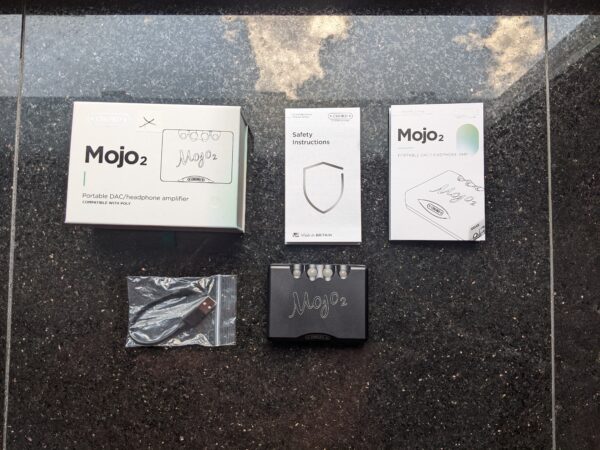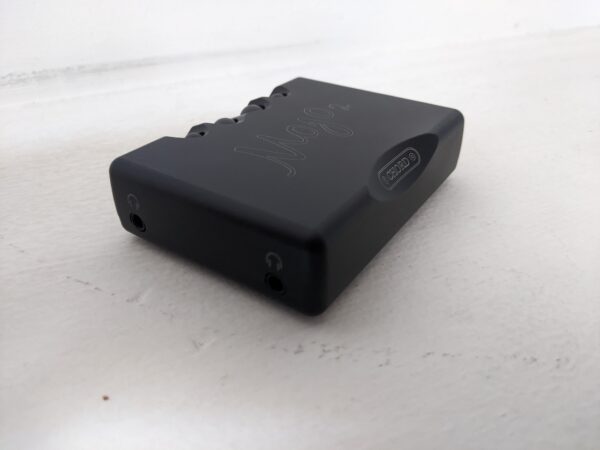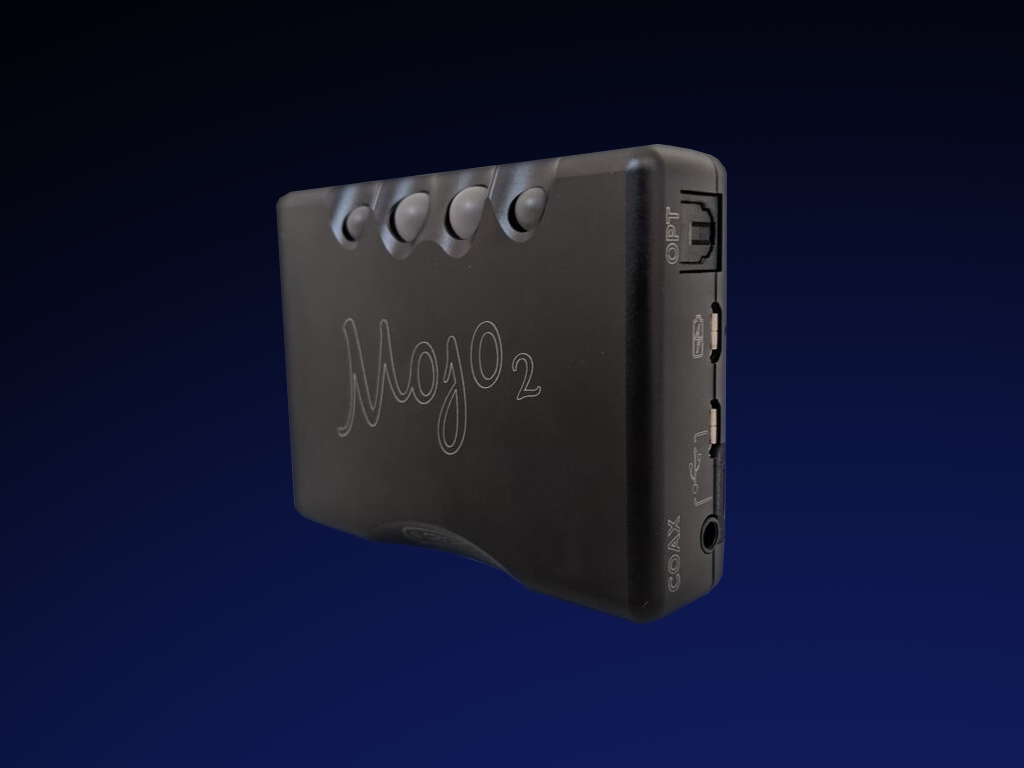Mojo 2 DAC/Headphone Amp Review
In 2015, the British company Chord Electronics released the original Mojo DAC/Headphone Amp, which was received with quite a bit of popularity. A whole seven years later, the Mojo 2 is now seeing the light of day much to the curiosity of listeners and audiophiles. With it’s inclusion of a fourth button, EQ features, several new modes and upgraded FPGA coding, the Mojo 2 seems to be offering a whole lot more than its predecessor. Let’s see what else is new before we have a listen.

What’s In The Box?
–Mojo 2 Portable DAC/Headphone Amp
-Micro USB to USB charging cable
-User documentation
-Mojo 2 Quickstart Guide
Look, Feel, and Design
Like the Mojo, the inclusion of not one but two 3.5mm headphone outputs is a simple yet somewhat serendipitous feature on the Mojo 2. This brings back vibes of sharing an earbud with a friend, or can be utilized for collaborative in-the-box mixing sessions. The Mojo 2 has the same inputs as the Mojo as well as a newly added USB-C input, a very welcome update that was noticeably missed on the original (to be fair, the first was released before the virtual ubiquity of USB-C). The same whopping 768 kHz sample rate is still supported on the 2.
The Mojo 2 is equipped with a flurry of new features centered around its inclusion of a fourth button, such as button lock mode, mute, crossfeed, and a particularly flexible tone control adjustment. It can also now be taken wireless by way of the Poly streamer/server. The Mojo 2 includes a lossless DSP, leading to tone control that has 0 degradation on audio quality. Perhaps the most important upgrade was to the specially designed FPGA coding which is the driving technical factor behind its digital-to-analog conversion. Battery life sees an upgrade as well, now clocking in at 8 hours.
Like the first Mojo, the 2 has some heft to it that makes it feel very sturdy and durable but also makes it a little burdensome to have in a pocket. This isn’t a very serious criticism, as it ends up having about the same pocket presence as wallet. Its metallic-black body gives it a fairly serious look that becomes a little more fun and musical with the inclusion of the color-changing buttons.
Output Power at 1 kHz/300 ohms: 90 mW
Output Power at 1kHz/30 ohms: 600 mW
Output impedance: 0.06 ohms
Dynamic range: 125 dB
Inputs: Coaxial, optical, Micro USB, USB-C
Outputs: 2x 3.5mm audio output
Max Sample Rate: 768 kHz

Neutral Sound Impressions
I used Beyerdynamic DT 770 Pro headphones to test the Mojo 2, as 1) They are particularly flat and analytical headphones and 2) they are my main pair, thus personally ideal for referencing subtle differences in tone and staging.
It’s fair to say that most listeners look towards their headphones to do the heavy lifting when it comes to sound character and coloration. An ideal headphone amp should, very generally speaking, be able to fly low and under the radar when it comes to it’s effect on timbre when set with a neutral EQ, and seek to maximize the relationship between the mix and whatever pair of headphones are plugged into it. The Mojo 2 meets this criteria, and produced subtle but noticeable improvements on my ol’ reliable 770’s.
The differences in tone that the Mojo 2 produced were most noticeable in the low end. Anyone familiar with 770’s knows their emphasis lies in the mids and highs, and are generally pretty resistant to subby rumbles. I was pleasantly surprised that it didn’t take much of a volume boost to get them rumbling along with Jai Paul’s album Leak 04-13 (Bait Ones). The subtle boost in the subs reached up into the low mids, producing a pleasant and slightly warmer sound than I’m used to getting from my 770’s.
The Mojo 2 produced a somewhat enhanced response to volume dynamics, making bass parts that were side-chained compressed to kick drums open and close more dramatically. The most noticeable difference, however, was in the imaging. There was a new found height in the sound stage of my 770’s, which usually run on a fairly flat left-right 2D plane.
Though I didn’t want to make myself deaf with too loud of a listen, it was obvious that the Mojo 2 could handle very high loudness levels and if anything would make my 32 ohm headphones distort before any distortion could be detected from the DAC itself. I had absolutely no skipping or clicking connectivity issues either, which is to be expected from a DAC with a wired connection but it is good to see nonetheless.
EQ Impressions
I’ll be honest, I generally don’t venture into custom EQ’s for various snobby reasons that I won’t get into here. That being said, I did have quite a bit of fun indulging in the EQ features on the Mojo 2. Boost/attenuation is available at 20 Hz, 125 Hz, 3 kHz, and 20 kHz in the form of parametric shelving. Though Q control is not “properly” available on the Mojo 2, the same effect can be achieved through creative shelving (I encourage you to consult the online user guide here as it provides a helpful visual explanation). I found the default Q of the shelves to be just right, as it avoided creating unwanted harmonic exaggerations, and made for surprisingly smooth and diverse custom EQ’s. My only criticism here is that the EQ controls might take some getting used to, as they’re indicated via color codes on the + and – volume buttons. Those who mix music will be at a slight advantage when it comes to making sense of the color coding, as the frequency-color coordination mostly mimics what you would see on Pro Tool’s default 7 band EQ. If you’re not immediately familiar with the standard EQ colors, you might want to carry around the small instruction manual in your wallet as a reference (at risk of onlookers identifying you as a massive audio nerd as you double-fist your DAC and instruction manual).
Overall
The Mojo 2 is the ideal 2022 upgrade that original Mojo fans have likely been waiting for. With its extremely clean and loud sound, new modes, customizable EQ’s and inclusion of USB-C, Chord Electronics have properly brought the charm and utility of the original Mojo into 2022. Those in the market for a versatile DAC that has years of value would be amiss to neglect checking out the Mojo 2.
Chord Electronic’s Mojo 2 can be bought at Audio46.

